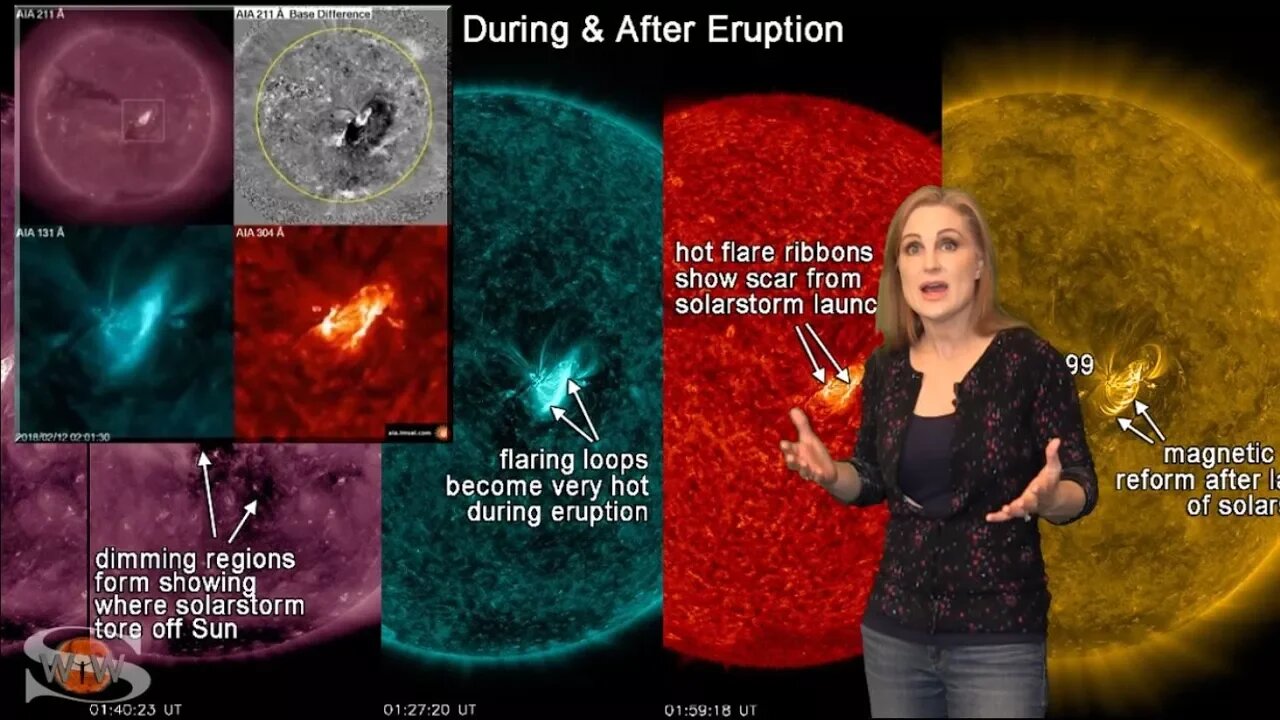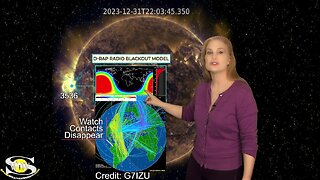Premium Only Content

Valentine's Day Aurora & A Bright Region Says Goodbye: Solar Storm Forecast 02-15-18
We await the arrival of the Valentine's Day solar storm, which will be followed by some fast solar wind just behind it. This means we should enjoy some extended storm conditions over the next few days with a chance for aurora down to mid-latitudes! Meanwhile region 2699 continues to boost the solar flux for amateur radio operators, but this will only last for a few more days until the region rotates onto the Sun's backside and out of Earth view. Learn the what kind of storm conditions to expect, when radio propagation for amateur radio and emergency responders will worsen, and why it can be hard to predict the arrival of some solar storms!
For daily and often hourly updates (during active times) visit me on Twitter:
https://twitter.com/TamithaSkov
For a more in-depth look at the data and images highlighted in this video see these links below.
Solar Imaging and Analysis:
SDO: http://sdo.gsfc.nasa.gov/data/
Helioviewer: http://www.helioviewer.org/
Flare Analysis: http://www.lmsal.com/solarsoft/latest_events/
Computer Aided CME Tracking CACTUS: http://www.sidc.oma.be/cactus/out/latestCMEs.html
GOES Xray: http://www.swpc.noaa.gov/rt_plots/xray_1m.html
SOHO: http://sohodata.nascom.nasa.gov/
Stereo: http://stereo.gsfc.nasa.gov/
GONG magnetic field synoptic movie: https://gong.nso.edu/data/magmap/standard_movie.html
GONG magnetic field synoptic charts: http://gong.nso.edu/data/magmap/
LMSAL Heliophysics Events HEK http://www.lmsal.com/isolsearch
Solar Wind:
DISCOVR solar wind: http://www.swpc.noaa.gov/products/real-time-solar-wind
ACE Solar Wind: http://www.swpc.noaa.gov/products/ace-real-time-solar-wind
NASA ENLIL SPIRAL: https://iswa.gsfc.nasa.gov/IswaSystemWebApp/iSWACygnetStreamer?timestamp=2038-01-23+00%3A44%3A00&window=-1&cygnetId=261
NOAA ENLIL SPIRAL: http://www.swpc.noaa.gov/products/wsa-enlil-solar-wind-prediction
Magnetosphere, Ionosphere, Atmosphere:
GOES Magnetometer: http://www.swpc.noaa.gov/products/goes-magnetometer
Ionosphere D-Region Absorption (DRAP) model: http://www.swpc.noaa.gov/products/d-region-absorption-predictions-d-rap/
Auroral Oval Ovation Products: http://www.swpc.noaa.gov/products/aurora-30-minute-forecast
Global 3-hr Kp index: http://www.swpc.noaa.gov/products/planetary-k-index
Wing Kp index prediction: http://www.swpc.noaa.gov/products/wing-kp
USGS Ground Magnetometers: http://geomag.usgs.gov/realtime/
USGS Disturbance Storm-Time (Dst): http://geomag.usgs.gov/realtime/dst/
NAIRAS Radiation Storm Model: http://sol.spacenvironment.net/raps_ops/current_files/globeView.html
Multi-Purpose Space Environment Sites:
NOAA/SWPC: http://www.swpc.noaa.gov
SOLARHAM: http://www.solarham.net/index.htm
Spaceweather: http://spaceweather.com
iSWA: http://iswa.gsfc.nasa.gov/iswa/iSWA.html
Definition of Geomagnetic Storm, Radiation Storm, and Radio Blackout Levels:
http://www.swpc.noaa.gov/NOAAscales/
None of this would be possible without the hard work and dedication of those who have provided all of this data for public use.
Images c/o NASA/ESA/CSA (most notably the superb SDO, SOHO, ACE, STEREO, CCMC, JPL & DSN teams, amazing professionals, hobbyists, institutions, organizations, agencies and amateurs such as those at the USAF/HAARP, NICT, NOAA, USGS, Environment Canada, Natural Resources Canada, Intellicast, Catatania, rice.edu, wisc.edu, sonoma.edu ucalgary.ca, rssi.ru, ohio-state.edu, solen.info, and more. Thanks for making Space Weather part of our every day dialogue.
-
 12:43
12:43
Dr. Tamitha Skov
1 year ago $0.22 earnedBiggest X-Flare of Cycle 25 & Super Storm Launch | Space Weather Spotlight 02 January 2024
611 -
 LIVE
LIVE
FusedAegisTV
5 hours agoHollow Knight Silksong Waiting Room ~~ pt. 2
57 watching -

TonYGaMinG
6 hours ago🌃 Neon Nights, Cyber Fights 🤘| Cyberpunk 2077 Live | PART 1
15.8K5 -
 15:27
15:27
Sideserf Cake Studio
1 day ago $12.05 earnedThis K-Pop Demon Hunters CAKE is how it's done, done, done!
57.5K15 -
 54:47
54:47
Side Scrollers Podcast
1 day agoSide Scroller Presents KING OF THE KART | MASSIVE MARIO KART TOURNAMENT
86.9K2 -
 LIVE
LIVE
Astral Doge Plays!
4 hours agoZelda NES Randomizer ~LIVE!~ Let the Randomization Begin!
108 watching -
 33:18
33:18
Athlete & Artist Show
14 hours ago $2.81 earnedHockey Is Back In Europe!
37.7K4 -
 5:33:30
5:33:30
Total Horse Channel
7 hours ago2025 URCHA Futurity | Derby & Horse Show | Sunday
45.9K3 -
 3:35:29
3:35:29
GhillieSuitGaming
4 hours ago $0.47 earnedThe Evil Within 2: Part 4 - Art Destruction!
9.92K3 -
 LIVE
LIVE
Chi-Town Gamers Livestreams
4 hours ago $0.56 earnedGears 5 Ep. 4 W/ CTG | Into Kait's Mental Issues | GOW: RELOADED LATER & SHENANIGANS 😎
18 watching